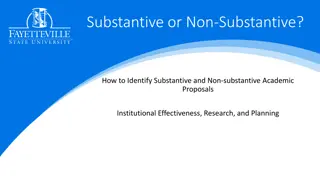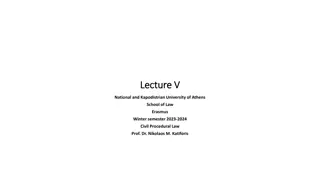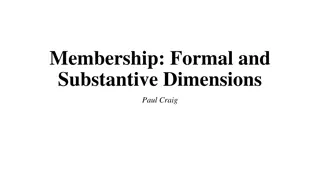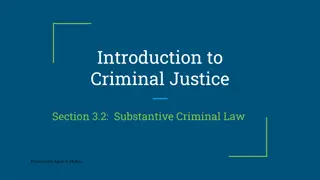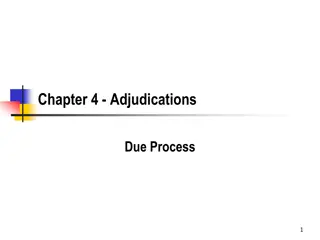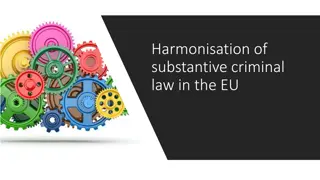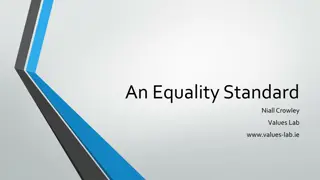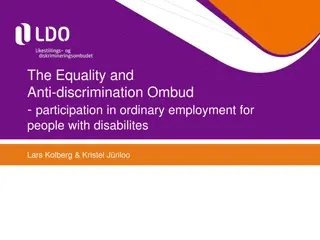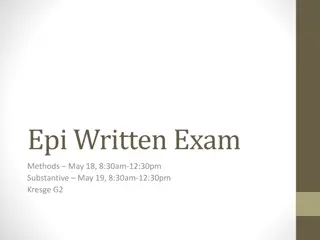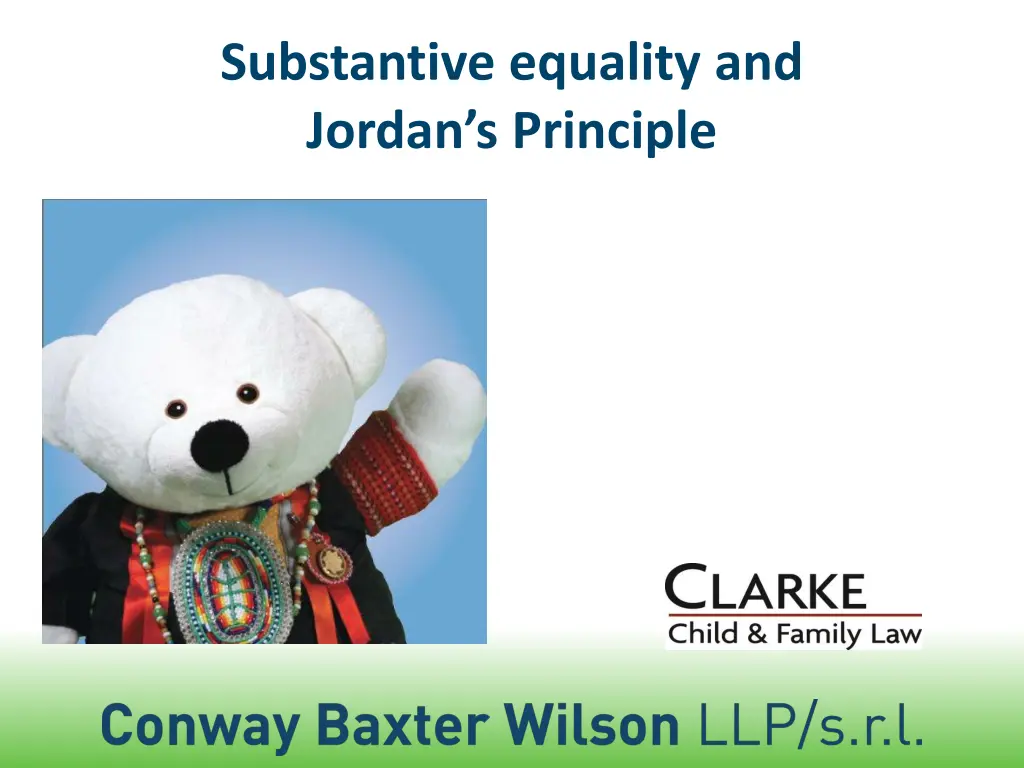
Understanding Substantive Equality and Jordan's Principle
Delve into the concept of substantive equality, emphasizing the importance of culturally appropriate services and individual needs evaluation. Explore the factors impacting substantive equality and how it addresses historical disadvantages. Discover the significance of providing support to ensure access to necessary services and avoid interruptions in care.
Download Presentation

Please find below an Image/Link to download the presentation.
The content on the website is provided AS IS for your information and personal use only. It may not be sold, licensed, or shared on other websites without obtaining consent from the author. If you encounter any issues during the download, it is possible that the publisher has removed the file from their server.
You are allowed to download the files provided on this website for personal or commercial use, subject to the condition that they are used lawfully. All files are the property of their respective owners.
The content on the website is provided AS IS for your information and personal use only. It may not be sold, licensed, or shared on other websites without obtaining consent from the author.
E N D
Presentation Transcript
Substantive equality and Jordan s Principle
2017 CHRT 14 [69] Furthermore, the emphasis on the normative standard of care or comparable services [ ] does not answer the findings in the Decision with respect to substantive equality and the need for culturally appropriate services.
2017 CHRT 14 [69] [cont d] The normative standard of care should be used to establish the minimal level of service only. To ensure substantive equality and the provision of culturally appropriate services, the needs of each individual child must be considered and evaluated, including taking into account any needs that stem from historical disadvantage and the lack of on-reserve and/or surrounding services.
Substantive Equality substantive equality requires attention to the full context of the claimant group s situation [ ] and to the persistent systemic disadvantages that have operated to limit the opportunities available to that group s members. - Fraser v Canada (AG), 2020 SCC 28 at para 42 [citations omitted]
Substantive Equality Factors (non-exhaustive) 1. Does the child have heightened needs for the service in question as a result of an historical disadvantage? 2. Would the failure to provide the service perpetuate the disadvantage experienced by the child as a result of their race, nationality or ethnicity? 3. Would the failure to provide the service result in the child needing to leave the home or community for an extended period?
Substantive Equality Factors (non-exhaustive) 4. Would the failure to provide the service result in the child being placed at a significant disadvantage in terms of ability to participate in educational activities? 5. Is the provision of support necessary to ensure access to culturally appropriate services? 6. Is the provision of support necessary to avoid a significant interruption in the child s care?
Substantive Equality Factors (non-exhaustive) 7. Is the provision of support necessary in maintaining family stability?, as indicated by: o The risk of children being placed in care o Caregivers being unable to assume caregiving responsibilities 8. Does the individual circumstance of the child s health condition, family or community context (geographic, historical or cultural) lead to a different or greater need for services as compared to the circumstances of other children (such as extraordinary costs associated with daily living due to a remote location?)
Substantive Equality Factors (non-exhaustive) 9. Would the requested service support the community or family s ability to serve, protect and nurture its children in a manner that strengthens the community or family s resilience, healing and self-determination?
Case Study (Yukon) - Council of Yukon First Nations submitted a Jordan s Principle group request to ISC, on behalf of Ross River Dena Council for Traditional/Nutritional Food Service for Daycare and School Age Children - Request was for hot breakfast and lunch service to 90 First Nations children and youth, five days a week ($423,020.64) - Request was denied as it was beyond the normative standard and that it did not ensure substantive equality in the provision of the services to the children
Case Study (Yukon) - Substantive equality factors cited on appeal: - 90% of Ross River s population are First Nations - Ross River Dena Council was one of only three First Nations in Yukon without a self-government agreement - Most of Ross River s First Nations residents were first- or second-generation descendants of survivors Lower Post Residential School (1951-1975) - Opening of the Faro Mine (1969, covering an area the size of Victoria), depriving RRDC of traditional hunting, trapping and fishing opportunities
Case Study (Yukon) - Substantive equality factors cited on appeal (cont d): - Faro Mine provided few jobs for First Nations people - Faro Mine closed in 1998, leaving behind 70,000,000 tonnes of tailings and 320,000,000 tonnes of waste rock - Letter of support from principal of Ross River school, speaking to her and her teachers experience of children coming to school hungry and unable to focus, with impact on learning activities - Letter of support from Yukon Chief Medical Officer of Health
Case Study (Yukon) - Substantive equality factors cited on appeal (cont d): - Canadian Institute for Health Information report noting the importance of optimal environments early in life for children, and the poor outcomes associated with adverse childhood experiences - Comparative median income data from 2015 of Yukon s Aboriginal and non-Aboriginal populations - Statistics regarding vulnerability at age 5 of children in Yukon and First Nations children generally - Grade 4 standardized test scores for Yukon First Nations students
Case Study (Yukon) - Substantive equality factors cited on appeal (cont d): - Canadian Institute for Health Information report noting the importance of optimal environments early in life for children, and the poor outcomes associated with adverse childhood experiences - Comparative median income data from 2015 of Yukon s Aboriginal and non-Aboriginal populations - Statistics regarding vulnerability at age 5 of children in Yukon and First Nations children generally - Grade 4 standardized test scores for Yukon First Nations students
Case Study (Yukon) - Substantive equality factors cited on appeal (cont d): - Remoteness (410 km from Whitehorse and poor highway conditions) - Removal of services from the community by territorial government - Income levels relative to other Yukon communities - Inclusion of traditional foods in the program - Result: Appeal allowed
Case Study (Northern BC Family) - Family submitted a request for a covered outdoor therapy space for their five year-old son ($19,699.70) - Family s son was diagnosed with Unspecified Anxiety Disorder and Regulatory Disorder of Sensory Processing - Covered outdoor therapy space was recommended by primary care physician and occupational therapist, so the family s son could engage in play therapy year-round
Case Study (Northern BC Family) - Request denied as based on the documentation provided the request does not have sufficient information to determine the product/service/support should be provided to ensure substantive equality
Case Study (Northern BC Family) - Substantive equality factors cited on appeal (cont d): - Further information regarding therapy required (specific information regarding nature and amount of heavy physical activities necessary to the family s son s development - Positive impact on the family s son s siblings - Long distance from the family s community to a larger community where services could be provided impeding frequency of services required - Lack of amenities in local community
Case Study (Northern BC Family) - Substantive equality factors cited on appeal (cont d): - Harsh local weather conditions in winter precluding the kind of outdoor activities required - Importance of remaining in the community to have access to the family s traditional hunting, fishing and trapping land - Result: Appeal allowed


